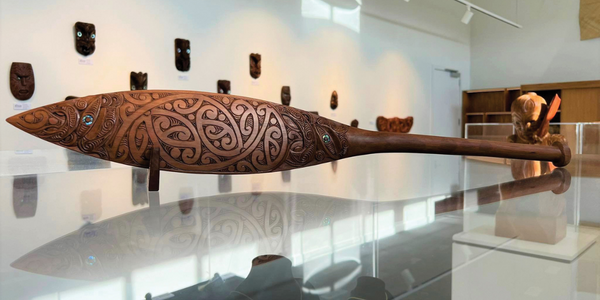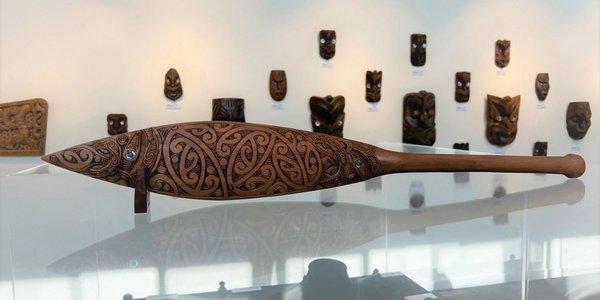What Kiwi businesses can learn from the Equifax data breach
A warning against complacency as the threat of ransomware and phishing attacks remains sky high.
Co-governance structure brings a unique opportunity for transformational change.

The two hoe (paddles) gifted to the chairs of Te Whatu Ora and Te Aka Whai Ora from the outgoing DHB chairs. An inscription on each plaque reads: Me huringa rau hou Me whakamau tātou ki te pae ora - hei oranga mō te iwi, mō tātou katoa. Let us turn over a new leaf. Let us seize the aspiration of a healthy future for all.

A radical new approach to the structure of our health system will be a new experience for even the most seasoned New Zealand directors.
The unique new system, which started on July 1, is one of the largest ever government reforms. District health boards have been disestablished and replaced with Te Whatu Ora | Health New Zealand and Te Aka Whai Ora | Māori Health Authority.
That means two organisations, with two governance structures, working alongside each other, sharing some resources and services, with a value of tino rangatiratanga (selfdetermination, sovereignty) in Te Aka Whai Ora.
Te Aka Whai Ora is chaired by Tipa Mahuta, an ex-district health board member, while Rob Campbell CFInstD chairs Te Whatu Ora.
Campbell is charged with overseeing the bringing together of the country’s 20 DHBs, 80,000 employees, an annual budget of $22 billion and a $24 billion asset base.
Both organisations take a joint role in developing system plans, and commissioning for primary, wellbeing and community services.
Te Aka Whai Ora is commissioning kaupapa Māori services and works with the Ministry of Health to develop strategies and policies for Māori.
District health boards have gone. Instead, new locality networks will provide advice to both organisations on the specific health needs identified by their communities. Within two years there will be between 60 and 80 localities running.
Experienced health sector governor Sharon Shea MInstD sat on both boards during the establishment phase. A member and a chair of multiple district health boards for over a decade, Shea says the co-governance structure is unique to health.
“In health, lives are at stake. It comes down to integrity within our relationships, which includes not being afraid to raise the issues and have some debate.”
“Some district health boards tried to effect partnerships with iwi based on equitable resourcing and sharing of power in decision-making, but not all were successful.”
Now a Te Aka Whai Ora director, Shea believes the new legislation will empower the health sector throughout the structure.
“With the new Pae Ora (Healthy Futures) Act, what were barriers have become enablers, with legislation designed from a Te Tiriti base which requires the Crown and Māori to work in partnership in the governance, design, delivery, and monitoring of services,” she says.
Outside of health, Mahuta quotes examples of bringing a suite of stakeholders together, such as North American National Parks and, in New Zealand, mature partnership governance arrangements based on the Treaty of Waitangi in environmental management areas.
“But this is new. The behaviours to support co-governance aren’t mature. We will have to unpack how it works, how we honour our people without having to continue to be defensive and qualifying our intention,” says Mahuta.
“There is a need to understand the history and the state of inequity in order to achieve equity.”
As both Shea and Mahuta say, “we have to level the floor to lift the ceiling”.
The establishment phase has been rapid, with both entities and their newly appointed final boards putting in the mahi with the guiding principle of Te Toki Waka Hourua: the double-hulled canoes of Te Whatu Ora and Te Aka Whai Ora working side-by-side for a common purpose.
Aligned with a Waka Hourua approach, CEOs, the chairs and both boards have taken a joined-up style, working collaboratively on many functions (such as national health sector planning), which draws on the legislation, the intention and the relationships.
The two CEOs – Fepulea’i Margie Apa MInstD and Riana Manuel – say they are ‘joined at the hip”, checking in with each other daily. “The boards have set the tone for how we work together,” says Apa.
Te Whatu Ora’s board has been appointed on typical Crown Entity terms, according to Campbell, who says they have already established a series of subcommittees to address people, finance, data, capital investment and clinical governance.
“While this element of the structure is quite generic, the executive and management structures at national, regional, district and local levels are highly specific to the delivery roles,” he says.
“We have paid a lot of attention to structuring the terms of reference and delegations to create both responsiveness and control, and we will continuously evaluate how that is working.”
Manuel is not oblivious to the fact they have a huge job on their hands with Te Whatu Ora folding 30 organisations into one, but says, like anything, when communication lines are strong things will work.
“If there is potential conflict, we will work in what I call ‘a partnerful way’. It’s just like a marriage, where there are two different people with different ideas, but with assets and structures that need to be looked after.
“It would be terrible if the relationship imploded between the two boards, that’s why we’ve put so much work into this. We all recognise history and have a shared interest in humanity.”
“If you have strong communication and are mindful of what the other party needs, even if you have to give up something from time to time, you make the appropriate spaces.”
Apa says “we expect friendly and constructive criticism as we move together and support the sector. We will have to be mindful of the pace of change and listen to our sector and stakeholders, including accepting that some things we already do are not broken.”
While the chairs are conscious that many things could go wrong, they are aware of the need to deliver.
“The cost of our inclusion has been seen by some as onerous and we could lose trust in confidence if we don’t do what we say we’re going to do,” says Mahuta.
“It would be terrible if the relationship imploded between the two boards, that’s why we’ve put so much work into this. We all recognise history and have a shared interest in humanity.”
That said, Mahuta and Shea are expecting some ‘rub’ between the different entities.
“In health, lives are at stake. It comes down to integrity within our relationships, which includes not being afraid to raise the issues and have some debate,” says Shea.
She says the directors will be focusing a lot on whānau voice to set the direction, rather than whānau just being viewed as passive recipients of health services.
“There is no such thing as neutral when you’re talking about equity and it is important for us to make our intent explicit. We’re not going to get the gains we need unless we’re clear.”
Amid these massive changes, the health system is facing huge pressure with limited staff to manage Covid-19, winter illnesses, the measles and the low rate of MMR vaccinations.
Some medical bodies called for the reforms to be postponed until after winter, but the government strode ahead. Campbell believes that was a good call.
“It made for some tough decisions, but they had to be faced and not delayed. I am not concerned that we still have governance gaps – the emphasis now is on getting management and delivery responsibilities in place.
“The operational issues are for all of us. It is our health system so change has to happen at all levels, and it is. The current pressure/crisis, call it what you will, both demonstrates the need for the reforms and incentives getting on with change,” says Campbell.
Apa says while their top priority is getting the right people, they won’t be tone deaf to the pressure happening on the front line.
When talking about the issues plaguing the health sector, Manual quotes Dr Curtis Walker as saying, ‘if we wanted trees we should have planted them 20 years ago; the best way to plant a tree is today’.
Her trees are many and include a strong belief in community-based care across governance.
“Covid was a real disruptor within health, which taught us all not just how to communicate remotely but also how to engage the community in health care.
“The community found itself having to engage in health care. When we needed a workforce, we didn’t have it and so we raised up the kaimanaaki (developing a community care model).
“It made for some tough decisions, but they had to be faced and not delayed. I am not concerned that we still have governance gaps – the emphasis now is on getting management and delivery responsibilities in place.”
“We micro-credentialed them and they were vaccinating and PCRtesting throughout two years. There is a lot you can do before people turn up at hospital, where communities can do more themselves and will then be able to better access care in a timely way.”
Manuel says they will look at what else the kaimanaaki could do that could then allow the nursing network to work more on speciality issues.
She wants to see more Māori clinicians trained and hopes to attract more New Zealanders back from overseas to the sector.
“We want to make health more attractive for everyone, and we want to grow a workforce that understands the different needs of our communities in both urban and rural settings.
“This structure means for the first time we can get a good overview nationally to see what the needs are for doctors, nurses and mental health workers so we can plan,” says Manuel.
CEOs and chairs are all aware that other government agencies will be watching closely to see how successful the new ‘double-hulled canoe’ will be.
And, in many ways, to truly support wellbeing in New Zealand, both Te Whatu Ora and Te Aka Whai Ora will need to lean on other agencies that have an impact on social determinants of health, such as housing and justice.
In the meantime, their vision is a fully transformed system, with localities feeding into a nationalised approach and a workforce delivering excellent service.